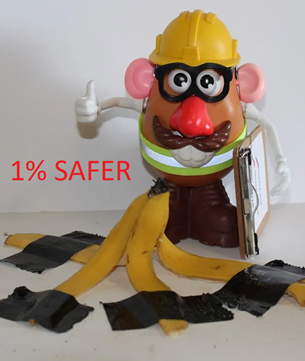The Fallacy of Marginal Gains and Nudges
 One of the characteristics of safety marketing is the continual clutching at straws to motivate and move people towards safety. We see this in the endless campaigns for: pickles, Mums for Safety, Hazardman, meerkats, sexy sofie etc.. It seems anything is justified as long as the word ‘safety’ is spoken, this includes using meaningless metaphors that try to make some connection to tackling risk. What this clutching at straws reveals is that Safety doesn’t really know what to do, other than run another marketing campaign. This is no more evident than in the 1% safer movement.
One of the characteristics of safety marketing is the continual clutching at straws to motivate and move people towards safety. We see this in the endless campaigns for: pickles, Mums for Safety, Hazardman, meerkats, sexy sofie etc.. It seems anything is justified as long as the word ‘safety’ is spoken, this includes using meaningless metaphors that try to make some connection to tackling risk. What this clutching at straws reveals is that Safety doesn’t really know what to do, other than run another marketing campaign. This is no more evident than in the 1% safer movement.
The idea of 1% safer is based on a measurement/numeric rationale arguing that small/marginal gains make a difference. What should be realized is that this argument is a quantitative argument that states a small numerical gain represents a qualitative outcome. What people don’t often realize is that the discourse (power in language) of the argument is numeric, not human. The language is about shifting a number and not about the essential human need for: care, helping, trust, belonging, forgiveness, understanding etc.
When this argument from quanta comes it states ‘can you make your business one percent safer’ (https://www.shponline.co.uk/leadership-and-innovation/one-percent-safer-book/). This question holds no interest for me and has no connection to the humanizing of safety, its just more numbers (https://www.shponline.co.uk/leadership-and-innovation/one-percent-safer-book/ ). How about Safety asks better questions like: how can we humanize safety? Why is safety not a helping activity? What does it mean to be professional? Why are ‘care ethics’ not the foundation for safety? What activities actually work to improve safety? (https://www.humandymensions.com/product/it-works-a-new-approach-to-risk-and-safety/) or perhaps another question: in whose interests and power does the 1% safer foundation serve? Is openness and transparency part of its ethic? Where dos the money go? And to whom?
Even when Safety argues it is ‘different’ it continues to speak in the language of ‘quanta’.
The marginal gains and 1% argument come from the world of the Olympics and human performance (https://hbr.org/2015/10/how-1-performance-improvements-led-to-olympic-gold). It is quite an Olympic leap to then jump from elite sports performance to the daily process of fallible humans tackling risk.
Of course, what you are not told in this spruiking of marginal gains is that there is no level playing field. Only the richest countries can afford the absurd outpouring of money to make a 1% gain in performance. This is justified by the ideology of gold medals. In Australia, gold medals is a religious pursuit, I would say a mental illness.
Just like zero vision, this 1% gain mindset is an ideology (https://www.svmglobal.com/blog/the-power-of-marginal-gains). Of course, you will never hear in this discourse the notion of fallibility (https://www.humandymensions.com/product/fallibility-risk-living-uncertainty/) or limits to performance. On the logic of this nonsense we should have a human run the 100m in 3 seconds one day.
Of course, what this ideology leads to is cheating, the unethical quest for gold that is now in the bloodstream of elite sports (https://www.forbes.com/sites/roomykhan/2017/12/31/doping-in-sports-cheating-or-leveling-of-the-playing-field/?sh=eadef5275ecf ). Whenever you see an ideology paraded in marketing the first question of a critical thinker should be: what are the by-products? And in safety, zero and 1% safer will lead to unethical outcomes because the numeric measurement of performance has now been made the goal. Lower order goals are always in dialectic with higher order goals (https://safetyrisk.net/goals-and-vision-in-safety/). The outcome of zero is not better safety but more brutal safety, more dehumanizing safety. This is because the ideology of the number governs the ethic.
Marginal gain and nudge theory hide key elements that are unethical. This is the ethic of ‘the end justifies the means’. Its rationale is: I can override your individual autonomy and manipulate your thinking because it gives the outcome I want. This is how we get such nonsense as ‘check your gut and do the right thing’ (https://safetyrisk.net/the-aihs-bok-and-ethics-check-your-gut/), the perfect deontological ethic to justify brutalism.
Nudge theory argues that manipulation of people is justified by the outcome, but at no time is the outcome and whom it serves questioned. Nudge theory comes out of ‘behavioural science’, hardly where one would expect some sense of expertise in ethics (https://onlinelibrary.wiley.com/doi/full/10.1111/phc3.12658 ). Similarly in Safety, this argument is ‘as long as injury rates are reduced the means is justified’. I call this brutalism, others call it 1% safer.
In the end, the nudge theory of 1% safer is neither a method or a strategy (https://safetyrisk.net/essential-elements-for-a-safety-strategy/) for anything. It is a marketing idea that is attributed to something that doesn’t exist, in the naïve belief that people will be motivated to improve behaviour because they have been fed a statistic. In short, it’s a con and doesn’t work. In a year it will be a new bell, whistle or yo-yo (https://safetyrisk.net/the-yo-yo-delusion-and-conversations-about-risk/) and the lemmings will fall in line once again with open wallets and wonder why safety doesn’t improve.



Do you have any thoughts? Please share them below